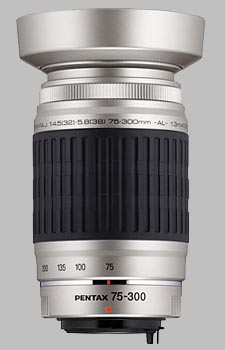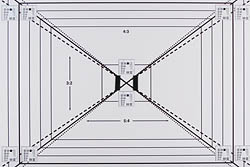| 75-300mm |
$185 average price |
|---|---|

|
|
Your purchases support this site
Buy the Pentax 75-300mm f/4.5-5.8 AL SMC P-FA J
(From Pentax lens literature) The Pentax SMC P-FA J 75-300mm ƒ/4.5-5.8 AL provides long telephoto coverage and is designed to be used with fully automatic cameras. Lightweight and easy to maneuver, it is an ideal zoom lens for beginners and advanced beginners. It features aspherical lens elements to help transmit light more efficiently and our acclaimed SMC multi-layer coating to lower surface reflection, reduce ultraviolet rays, and deliver clear, high-contrast images.
SLRGear Review
April 20, 2008
by Andrew Alexander
The Pentax 75-300mm ƒ/4.5-5.8 FA-J was released following the then-new *ist film SLR, in February of 2003. The lens is still widely available, in either an all-black finish or a silver/black color scheme.
The lens is designed to fit the a standard 35mm image circle, so it should work fine on a film body; however, being a FA-J series lens, there is no aperture ring, so your film body will have to be able to set the aperture on the lens. The lens is a variable aperture lens, in that as you increase the focal length, both the maximum and minimum aperture sizes decrease. The following table reflects the change in aperture with focal length:
| Focal Length | 75-170mm | 190-270mm | 300mm |
| Largest aperture | ƒ/4.5 | ƒ/5.6 | ƒ/5.8 |
| Smallest aperture | ƒ/32 | ƒ/40 | ƒ/40 |
Observant readers will note the jump in focal lengths in the table; the K100D Super test body we used was only so accurate with regard to the reporting of the focal length set. For example, while it's possible to set the length to what would physically be 180mm, the camera will report it as 190mm.
The lens takes 58mm filters, comes standard with a circular-style lens hood, and is still available for around $120.
Sharpness
The 75-300mm ƒ/4.5-5.8 shows average to below-average results for sharpness, with particularly poor results at 300mm. Its optimum sharpness can be achieved by setting the lens to 100mm and ƒ/8-11, where it shows very sharp images, between 1-2 blur units.
The lens performs better on the wider angle than the telephoto, with a slim sweet spot of sharpness at all apertures when set to 75mm. Corner softness is a bit of an issue at this setting, and it doesn't really go away completely until ƒ/16. 100mm offers better performance when set to a wide aperture, and becomes very good at ƒ/8 to ƒ/11, almost tack-sharp. It's as good as it gets with the lens.
Telephoto results become progressively less sharp as focal length increases, until by 300mm and ƒ/5.8 the image sharpness is very uneven and exceeding 7 blur units. Image quality improves at these telephotos with the aperture set to ƒ/11 and above - between 3 and 5 blur units.
Chromatic Aberration
Results for chromatic aberration performance are also average, with better tolerance in the wider angles than telephoto. Chromatic aberration is more evident in the corners than the center, as you'd expect, and with 3/100ths of a percent of frame height showing chromatic aberration between 75-100mm and ƒ/4.5-ƒ/8, this is actually quite good. However, chromatic aberration becomes much more noticeable into the telephoto range and smaller apertures, with corner results showing 9/100ths at 300mm, and more importantly, 6/100ths in the central region of the frame.
Shading (''Vignetting'')
If the lens were to have something in its favor it would be its results for vignetting - there's virtually no corner darkening to speak of at any focal length and aperture combination. With the aperture set to its widest setting, the worst case scenario is a quarter-stop difference between the corners and the center, and that's at 300mm.
Distortion
The 75-300mm ƒ/4.5-5.8 also handles distortion very well, with a very slight barrel distortion being detectable through the entire image throughout the focal range. Pincushion distortion evolves after 85mm, but it doesn't exceed -0.3% after 130mm.
Autofocus Operation
The 75-300mm has a fair amount of glass to push around, and newer lenses do it better: autofocus is comparatively slow, taking 1.7 seconds to rack through from closest to infinity and back when mounted on our K100D Super. Point to point focusing, however, is comparatively quick. Being mechanically driven, it's somewhat noisy when focusing.
Macro
Macro performance is above-average for a non-dedicated telephoto zoom lens, with a magnification ratio of 0.3x, and a close-focus distance of 1.3m (4.3 ft).
Build Quality and Handling
The FA-J series of lenses are very much a ''budget'' lens - all plastic construction, rotating filter rings, no aperture ring. That said, the use of plastic instead of metal makes for a much lighter lens.
Zoom operation is conducted with the wider (2-inch) ring, made of a ribbed plastic that has good feel. The full zoom range is accessible with a quarter-turn of the ring, and the zoom stops are spaced out well. There isn't much resistance in the ring however, which doesn't add to the overall quality of the lens. Zoom creep is an issue with this lens; it doesn't take much movement to extend the lens to its full length. Zooming to full telephoto almost doubles the lens' length to 160mm (6.3'').
Manual focus is conducted by disabling autofocus on the camera body. The focus ring is a half-inch wide, and simple ridged plastic. There isn't much feel to the ring, but there is plenty of travel, at well over a half-turn taking the lens from close-focus to infinity. While focusing, any attached filters will rotate, making the use of a polarizer a bit more challenging. There is further lens extension during focusing, with the lens extending an additional 20mm (almost an inch) at infinity.
Alternatives
Pentax 50-200mm ƒ/4-5.6 ED SMC P-DA ~$200
Sharper, better chromatic aberration performance, acceptable vignetting but slightly worse distortion. Internal focusing and ''quick-shift'' AF/MF switching make this a far better value for the money; however, it's designed for subframe (APS-C) sensors, so vignettes on full-frame bodies at 135mm or higher.
Pentax 55-300mm ƒ/4-5.8 ED SMC DA ~$400
A fairly new offering from Pentax, we haven't yet tested it, but it seems to offer a longer telephoto end at the expense of the tiniest bit of maximum aperture.
Pentax 100-300mm ƒ/4.7-5.8 SMC P-FA ~$?
We haven't tested it, and the challenge if you were considering this lens would be to find a copy. The sole user review on it is fairly supportive, however.
Sigma 70-300mm ƒ/4-5.6 DG Macro APO ~$180
The only third-party product available in the same range on a Pentax K-mount, we haven't tested this lens; it has a few more glass elements, though opinion is mixed in the user reviews.
Conclusion
If you're looking for a telephoto zoom and are tight on money, then you'll probably make out alright with this lens; set to 100mm and ƒ/8 or ƒ/11, results are very good. It's when you take the zoom above 100mm that it begins to show its flaws. If you can afford a few extra dollars, they're well-spent on the Pentax 50-200mm ƒ/4-5.6, or possibly the Pentax 55-300mm ƒ/4-5.8.
Sample Photos
The VFA target should give you a good idea of sharpness in the center and corners, as well as some idea of the extent of barrel or pincushion distortion and chromatic aberration, while the Still Life subject may help in judging contrast and color. We shoot both images using the default JPEG settings and manual white balance of our test bodies, so the images should be quite consistent from lens to lens.
As appropriate, we shoot these with both full-frame and sub-frame bodies, at a range of focal lengths, and at both maximum aperture and ƒ/8. For the ''VFA'' target (the viewfinder accuracy target from Imaging Resource), we also provide sample crops from the center and upper-left corner of each shot, so you can quickly get a sense of relative sharpness, without having to download and inspect the full-res images. To avoid space limitations with the layout of our review pages, indexes to the test shots launch in separate windows.
Pentax 75-300mm f/4.5-5.8 AL SMC P-FA J
Your purchases support this site
Buy the Pentax 75-300mm f/4.5-5.8 AL SMC P-FA J
Pentax 75-300mm f/4.5-5.8 AL SMC P-FA J User Reviews
-
Inexpensive, SMC coating, LightNot the sharpest zoom lens, no quick-shift manual focus, no macro, slow AF
Decent build quality considering price, although this lens is entirely made of plastic. Which also makes this lens light and comfortable to carry around. I haven't experienced any zoom creep issues yet. Silver looks good too.
reviewed May 28th, 2008 (purchased for $180)
Images are not tack sharp at full zoom, there are sharper telephoto zooms out there. No quick shift manual focus like the pentax 55-200 DA, so you'd need to click to MF on the camera body before you can manual focus. Slow Auto Focus. No macro on this lens, so closest focus distances are quite far. You'd need a close up filter for macro nature shots. -
cheap lens a little bit above average result.Plastic quality and can become dirty quickly
Ok this is a tricky lens for review...
reviewed January 12th, 2007 (purchased for $189)
first it gave me a little bit above average picture quality...
its plastic so I didnt except much out of it.
But after just a week I began seeing in my viewfinder something like dust all over... it was no more clear... so I dunno if its the bad material inside or the bad joints but dust or dirt went either at the back or at the front ...
I was first thinking it was my filter but after changing it was not.. soo I have mixed feeling at the moment..
Still hoping its my usage but dont except much out of this lens...
but still recommend if its around 100$ US but dont except much out of this... I've used Sigma 70-300 apo dg and its a totally different quality than this... -
good cheap lens , good image quality
reviewed January 1st, 2007





